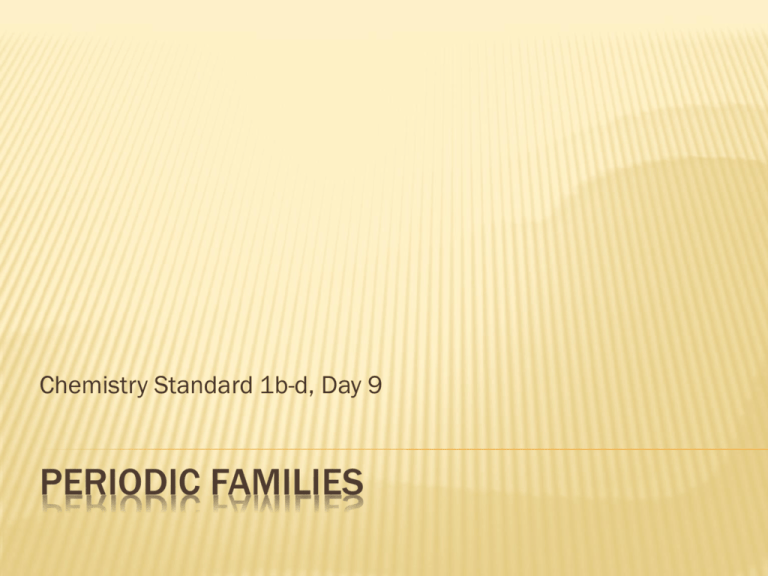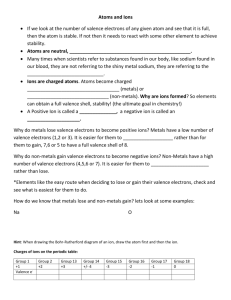Periodic Families
advertisement

Chemistry Standard 1b-d, Day 9 PERIODIC FAMILIES GROUPS Using the PT I gave you color code and label the groups AKA families, valence electrons, and charges. ALKALI METALS 1 valence electron. Most reactive metals and are always combined with another element. ion/oxidation= +1 ALKALINE EARTH METALS Second most reactive metals and are always combined with another element 2 valence electrons. Ion/oxidation= +2 TRANSITION METALS Not very reactive Valence varies All metals will give away electrons (positive charge) oxidation numbers vary Form metallic bonds BORON FAMILY 3 valence electrons Ion/oxidation= +3 CFU: PAIR SHARE Which family is the most reactive of all metals? How many valence electrons will Alkaline have? What charge will all metals have? CARBON FAMILY 4 valence electrons. Ion/oxidation= +4 The element carbon is called the “basis of life.” There is an entire branch of chemistry devoted to carbon compounds called organic chemistry. CST QUESTION NITROGEN FAMILY 5 valence electrons. Ion/oxidation= -3 The nitrogen element is necessary to form proteins. Proteins are macromolecules that express heredity OXYGEN FAMILY 6 valence electrons. Ion/Oxidation= -2 Oxygen is the most abundant element in the atmosphere Needed for cellular respiration which maintains life CFU What is the ion charge for the nitrogen family? What family does the calcium atom belong to? How many valence electrons will aluminum have? HALOGEN FAMILY 7 valence electrons Ion/oxidation= -1 Most active non-metals Always combine with other elements Halogen atoms only need to gain 1 electron to fill their outermost energy level. They react with alkali metals to form salts. NOBLE GASES 8 valence electrons (He 2 valence) Extremely un-reactive. They are inactive because their outermost energy level is full. AKA inert gases because they don’t react RARE EARTH ELEMENTS lanthanide and actinide series. Most of the elements in the actinide series are called trans-uranium, which means synthetic or man-made. CST Release Questions 8. Iodine would have chemical properties most like A manganese (Mn). B tellurium (Te). C chlorine (Cl). D xenon (Xe). 5. The chart above shows the relationship between the first ionization energy and the increase in atomic number. The letter on the chart for the alkali family of elements is A W. B X. C Y. D Z. 10. Which of the following ordered pairs of elements shows an increase in atomic number but a decrease in average atomic mass? A Ag to Pd B Co to Ni C Ge to Sn D Cr to Mo




